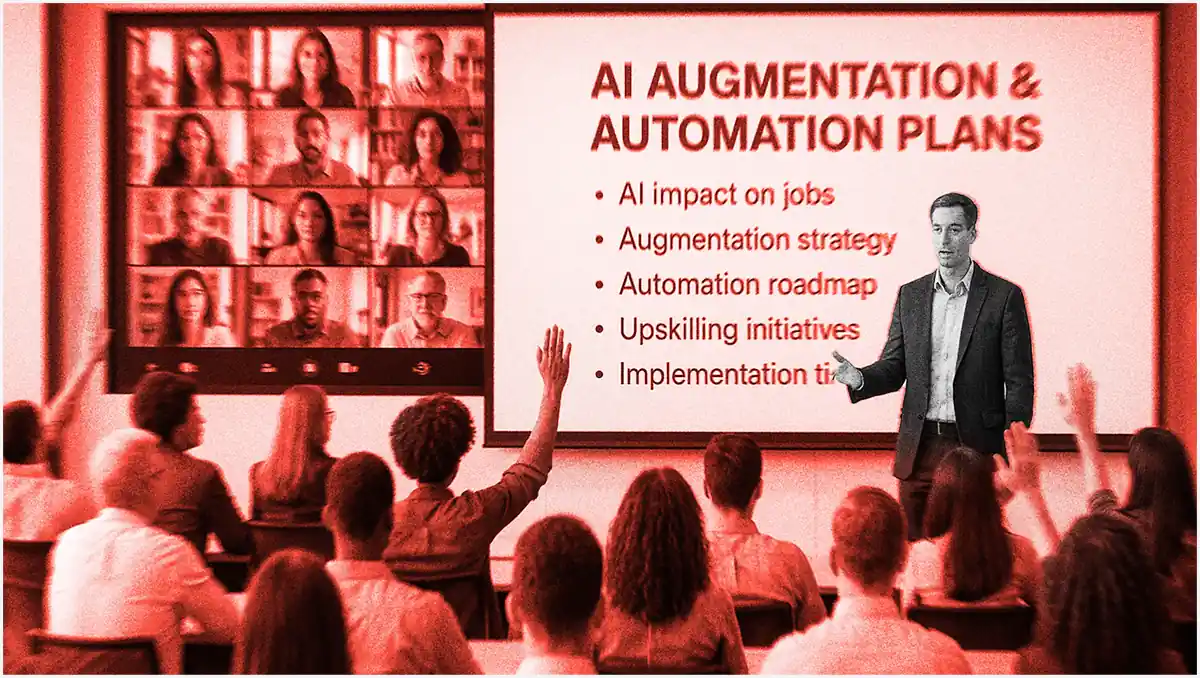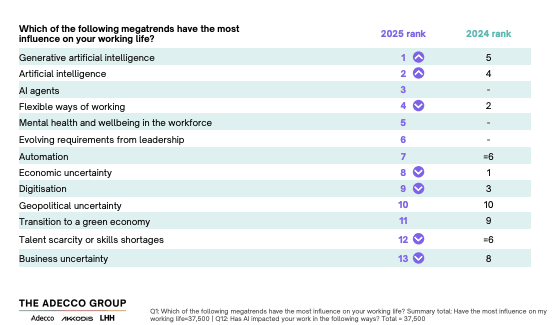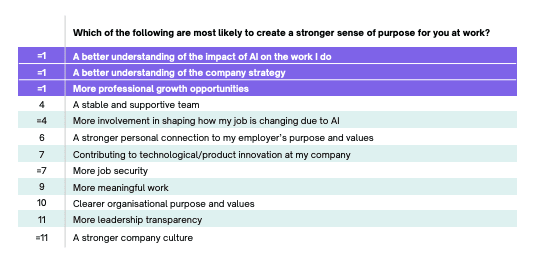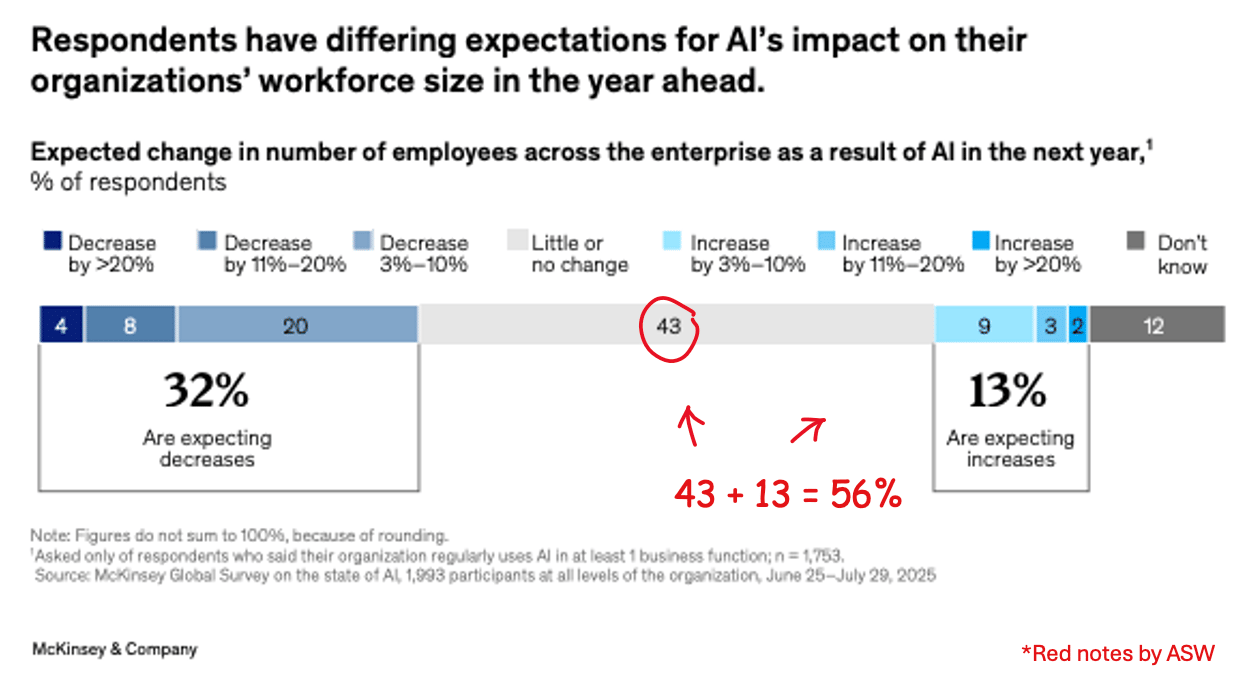Face AI Fears & Facts

AI is disrupting work and workers. Uncertainties are unsettling. Job insecurity is generating anxiety. Employees often fill in information gaps about AI integration with fear-based narratives. Recognize how headlines citing general potential negative AI impacts undermine your workforce focus and disrupt your business results. Be transparent about AI possibilities. Involve employees in the process.
“I’m telling them, ‘Guys, you are going to stay here, but you need to be the change agent. You need to evolve yourself,’ ” Yoffe said. “You’re smart enough to work here, but you’re not going to do the same job in two years. Embrace the moment.” — Omri Yoffe, CEO, Vi.
Facing Reality?
Headlines and articles are currently focused on how AI will replace people's jobs, fueling employee fears. What are the facts? A WSJ article late September stated "Companies including ...JPMorgan...have bluntly predicted job losses associated with AI." What JPMorgan's CEO has reportedly said:
"AI will enhance some aspects of work, but also eliminate some jobs.”"We'll have more jobs, but there'll probably be less jobs in certain areas" — Jamie Dimon, CEO, JPMorgan Chase quoted in Times of India.
The differences are meaningful when it's your job at stake. Or you think it might be. You can still engage in your daily work if you expect some disruption and to need to move internally, not out. But if you don't know? What/who to believe?
AI Labour Losses?
Referring to the quote above, Yale researchers note:
"AI is already replacing thousands of jobs per month, report finds" (Aug, 2025).
"1 big thing: "Boomerang" hires hint AI layoffs don't stick" Axios (Oct, 2025).
"AI Job Loss Statistics 2025: Who's Losing, Who's Hiring, and What Comes Next" SQ Magazine (Oct 2025) includes numerous global and national data, many describing negative potential with a few positive. Which do you notice?
"The broader labor market has not experienced a discernible disruption since ChatGPT’s release 33 months ago, undercutting fears that AI automation is currently eroding the demand for cognitive labor across the economy." — The Budget Lab at Yale University, October 2025
Referring to the quote above, Yale researchers note this counters "the most alarming headlines," explaining that technological disruption in workplaces usually "occurs over decades, rather than months or years." For those without job security, does this register?

Stanford research also finds (page 3) substantial employment declines for early-career workers in occupations most exposed to AI (software development and customer service) compared to more experienced workers in the same occupation. They comment later that this trend would also be consistent with a weakening labour market. Nuances are complicated. The situation is unclear.
Uncertainty Undermines
How concerned are employees? Very. 89% of US workers worry about AI-driven job displacement [Resume Now 2025 AI Disruption Report ]. 53% of frontline employees trust their leaders to implement AI responsibly [Qualtrics, State of AI in Employee Experience, 2025] which doesn't help. Trust is low.
GenAI/AI/AI agents are megatrends #1, #2, and #3 cited as having 'the most influence' on the working life of workers globally [Adecco Group 2025].

Whatever the general trends, what matters is your company, workforce, and business dynamics to determine how AI is being integrated and likely to impact operations and jobs. Employees recognise AI is already changing their work:
- 77% say AI allows them to perform tasks they couldn't do before.
- 62% say AI has changed the skills required for their role, 11% say it will.
- 60% say AI has changed their work activities, 12% say it will [Adecco].
People are adapting, even without their employer investing in the AI training needed. 38% of employees feel pressure to increase productivity although there may not be clarity about how AI will help [Qualtrics]. However, what matters to employees? What drives engagement in their work? Tied equally is: their growth, the company's direction, and how AI will affect them [Adecco]:

Pay attention to the negative articles - from the impending or potential AI crash (What does that mean? What's the likely versus worse case scenario?) to job disruption versus destruction. Read research carefully to get a balanced read.
Currently, weak economics may have more impact on jobs than AI. Job replacement is limited and company/sector/discipline specific — so what are your company specifics? Make explanatory data available. Involve workers in AI-related plans to reduce fear, solicit their ideas, engage them in problem-solving.
"It's not clear how much of the layoffs have actually been driven by AI doing people's jobs as opposed to AI giving cover to take away people's jobs" — Professor Gary Marcus, Professor Emeritus of Psychology and Neural Science, New York University, interview November 2025.
Inform & Involve

If you're in the 56% (above) expecting to increase or little/no change in employee numbers because of AI in the next year, share these expectations. Reduce employees' fears of layoffs. Discuss with them how/where AI can best contribute and complement, including digital labour joining teams. PLUS openly acknowledge simultaneously shifting tasks, job evolutions, re/upskilling needs - they must still absorb and adapt to substantial change in their daily work.
If you're in the 32% expecting negative workforce impact, employees likely already know or suspect. Everyone is worried. Those hoping to remain are watching. Their engagement will be affected by how others are treated. For people in highly-exposed jobs, are skills identified, is re/upskilling/redeployment possible? Will outplacement support be offered. Do partners need their skills?
If you're in the 12% that "don't know," resulting from significant evolution in your business model, huge effects mid digital transformation, supply chain (tariff-based?) disruption or another reason. You need more clarity. Everyone is worried. Distracted, they cannot engage well to secure future business growth. Share issues, discuss tradeoffs and opportunities, discover solutions together.
"It’s very clear that AI is going to change literally every job."“Our goal is to create the opportunity for everybody to make it to the other side.” — Doug McMillon, CEO Walmart, September 2025.
Key Recent Research:
- The State of AI in 2025. McKinsey & Co.
- Global Workforce of the Future, 2025, The Adecco Group.
- Canaries in the Coal Mine? Six Facts about the Recent Employment Effects of Artificial Intelligence. Erik Byrnjolfsson, Bharat Chandar, and Ruyu Chen, Stanford University.
- Evaluating the Impact of AI on the Labor Market: Current State of Affairs. The Budget Lab, Yale University.
Digital DNA

Human-centric workforce innovation in the age of AI
workforce and scale your business, navigating the fast-paced
unpredictable marketplace.
Generational EQ

Today’s potential buyers are distracted, hesitant, and harder to read. Tactics that used to work — well-crafted pitches and persuasion — don’t land the same way anymore.
If you’re trying to reach prospects or upsell existing customers who are cautious or uncertain, it’s time to change your approach.
That’s what Selling with Empathy is designed for. My new course helps sales professionals and leaders connect, develop relationships, understand what drives decisions, builds trust and turns hesitation into a confident conversion.
Inside, you’ll find 17 comprehensive lesson packages, each with a video, key takeaways, quiz, and exercises with downloadable worksheets, giving you a proven, step-by-step way to:
· Uncover what’s behind potential buyers' resistance
· Increase conversions without adding pressure
· Build long-term client relationships and improve upselling
For those ready to dive deeper, the first five people who register will receive a free 30-minute private 1:1 session with me to discuss your real-world challenges—in sales and other areas.
Course Price: $299 USD | £227 GBP | €257 EUR
If prospects are harder to reach and customers harder to upsell, this course will show you how to connect — with clarity, empathy, and impact.
Distributed Works

Scaling Skills-first

Who's Facing Fears & Facts
Walmart is frequently tracking AI's increase/decrease/neutral impact by job type to see where employees may need training and preparation. Headcount is projected to be steady for three years as the mix changes: job cuts result from warehouse automation while adding AI-related and high touch customer roles.
Thomson Reuters teams brainstorm use cases to build curiosity. Their "Open Arena" internal 'sandbox' fosters a culture of experimentation giving AI tools access to all 27,000 employees with ~400 AI super-users. Global Learning Days discuss how AI supports colleagues, not just customers [read more].
Salesforce is 'building trusted, human-centered agentic AI' emphasizing people, product, and community and promoting a 'future workplace where humans can thrive with AI.' They believe Agentic AI must be designed with trust and intention (and safe and ethical) as adoption hinges on user confidence.
Agricultural company, Syngenta, has "lighthouse projects" in R&D and supply chain functions looking for AI options. Teams will regularly represent findings to the CEO identifying new approaches and AI-ready leaders.
"Humans and AI working together, you get more value from both" — Hayden Brown, CEO, Upwork speaking at Web Summit Nov 11 2025.
Transparency & Trust
- Transparency building trust - Share (more) about your company's AI strategy. Be open about AI tools being piloted, which roles/tasks are currently/soon evolving, what skills each person is likely to need, and how they will be supported. Use employee inputs to improves plans and engage (especially young) workers in exploring additional options.
- Skills and role evolution - Recognise the shift from 'jobs' to 'skills and projects' identifying roles where tasks are being automated or augmented and map the “new” role within a framework that allows evolution. Invest in upskilling around digital dexterity, empathy, cross-silo collaboration—especially for mid-career managers bridging Gen X and Z.
- HR + IT + FM alignment - Integrate AI into the human-centric system (Customer Journey and Employee Journey). Where does the “Employee Journey” benefit from AI agents? How is IT redesigning workflows, supporting humans, measuring outcomes, rather than deploying tools and saving costs. How can AI optimise flexible schedules and space?
- Workforce vulnerabilities - Entry-level hires, apprenticeships, early-career roles often feel the first effects—from fewer openings or task redesign. Actively design “growth pathways” for early-career talent to improve trust, engagement, upskilling opportunities, and retention.
- Communication and feedback - Leaders must create active dialogues: town halls, workshops, and micro-learning sessions where workers can ask “What’s happening to my role?” Use data and storytelling: “Here’s how our AI pilot is progressing" "Here’s what we found" "Here’s how your role will shift" "Here’s training we’re offering.” Monitor employee sentiment, psychological safety, and readiness for change.
Your workforce needs to know:
- What is changing.
- How it will affect their role and growth.
- What the support plan is.
- What the organisation expects.
When you supply facts, you reduce fears. When you involve people, you increase trust, and harness the uniquely human capabilities that are critical for the success of your business: critical reasoning, problem solving, connection, collaboration, judgment, and empathy.
Human-centric Leadership Audit

News & Muse

📹 When Will the AI Bubble Burst, Gary Marcus with Murad Hemmadi, Nov 25
📘 The Coming Wave: AI, Power and Our Future, Mustafa Suleyman, Oct 24
🗞️ New data show no AI jobs apocalypse—for now, Brookings, Oct 25
🎶 Better Together, Jack Johnson.
AI is disruptive. How it will affect each person's working life over time is not yet clear. As a leader, your role is to make the uncertainty less threatening, not by pretending that everything will stay the same, but by being human-centric in how you design and co-create the transition.
With extensive business strategy expertise combined with human understanding of evolving Future-of-Work issues, I offer intelligence and insights to leaders to better understand and tackle strategic and tactical issues and scale through uncertainty. Click here to book a 30-minute session.
Until next time!
Sophie
Scalable strategies. Tactical talk. Workforce transformation.
Human-centric workforce innovation in the age of AI
workforce and scale your business, navigating the fast-paced
unpredictable marketplace.
